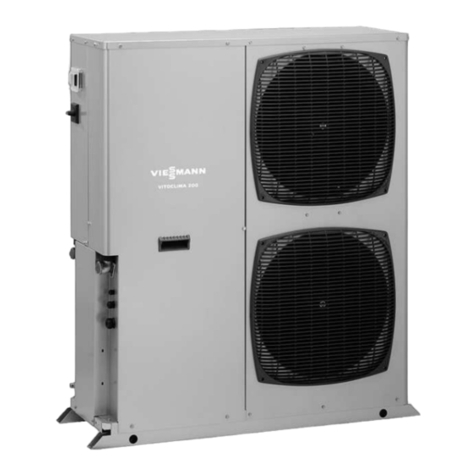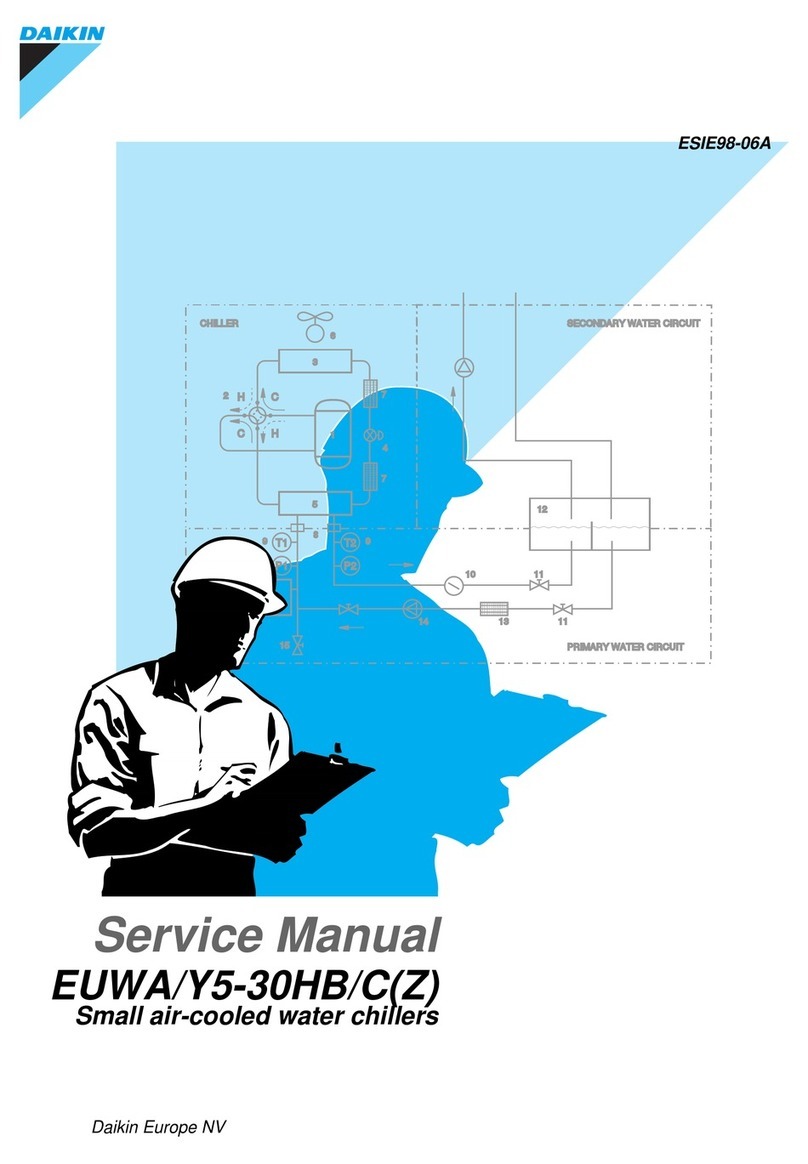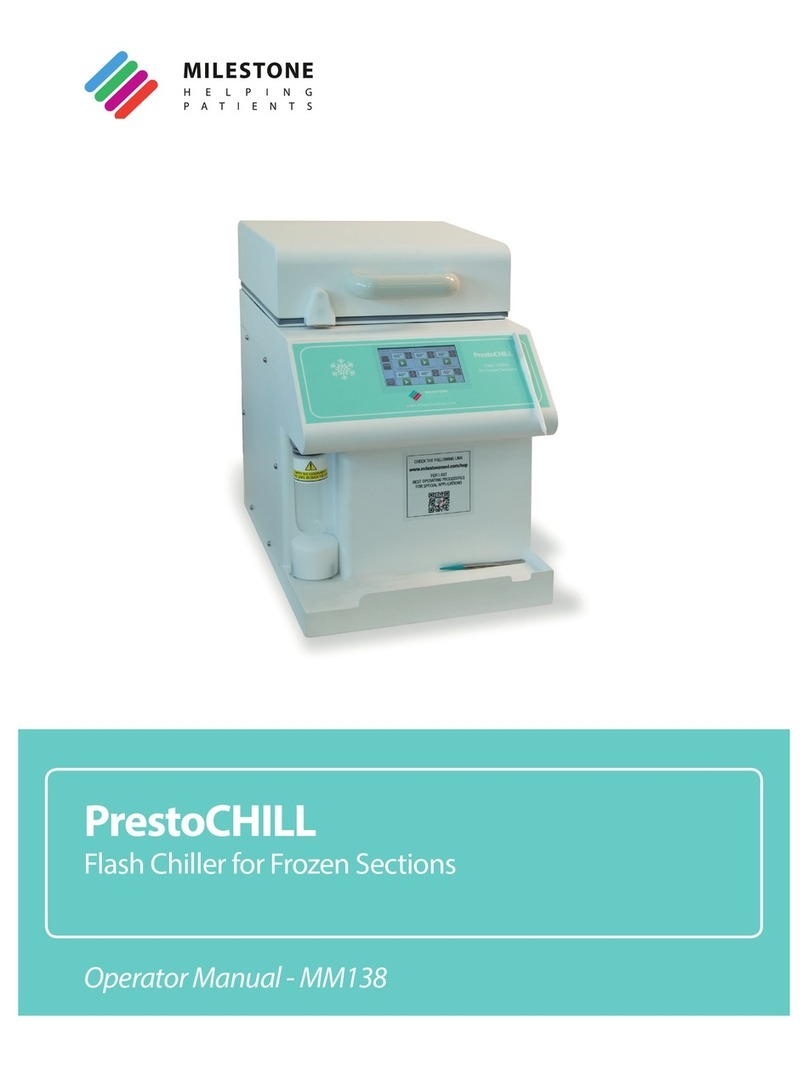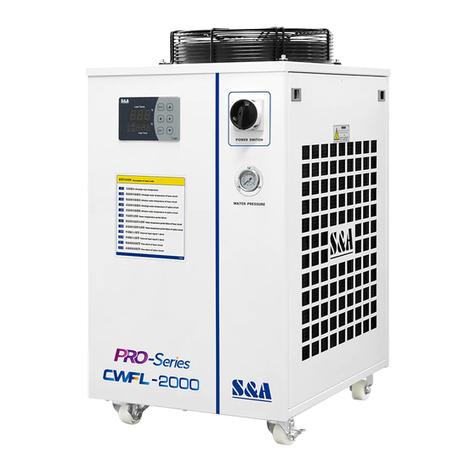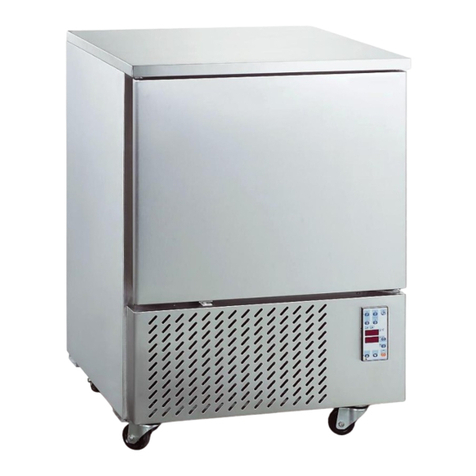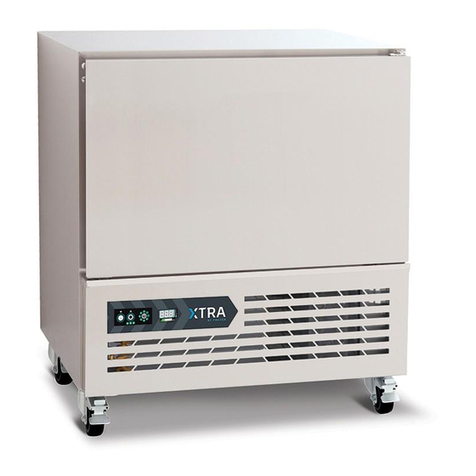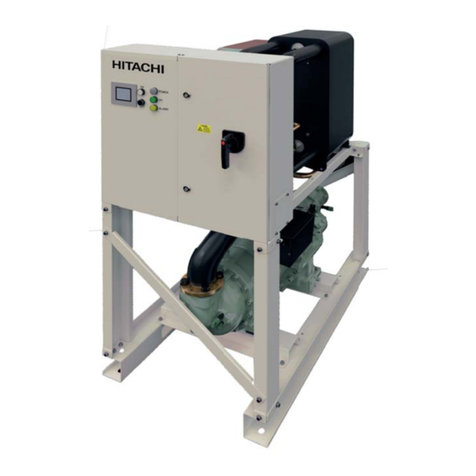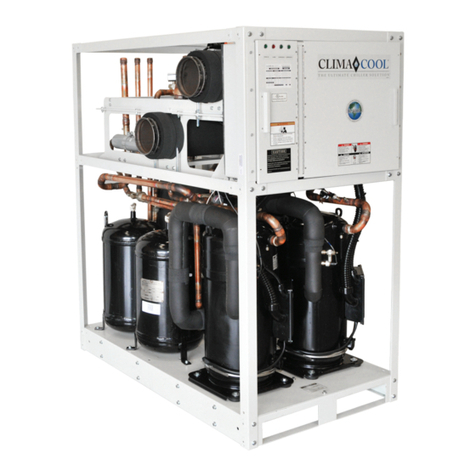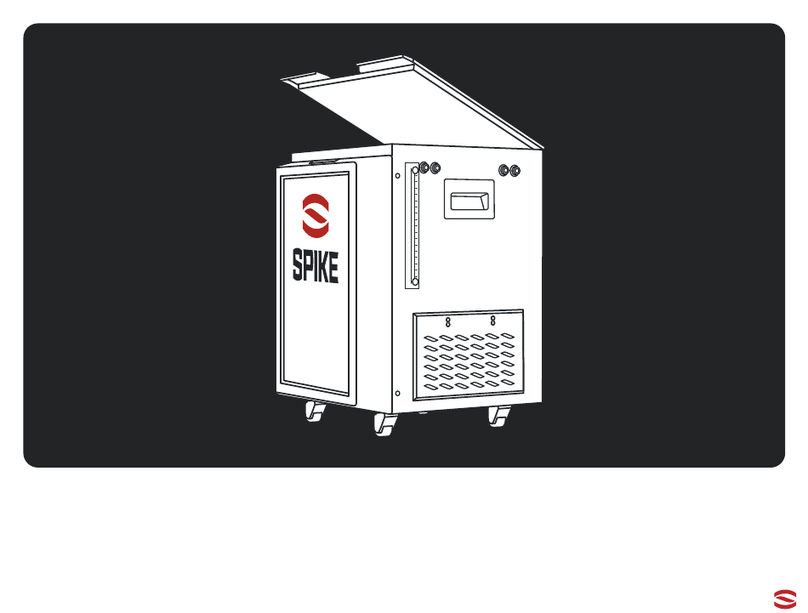Viessmann Vitoclima 200-C Operating instructions

VIESMANN
Service instructions
for contractors
Vitoclima 200-C
Chillers for external installation as 230 V version
For cooling as well as for cooling and heating operation
For applicability, see the last page
VITOCLIMA 200-C
5692 695 GB 2/2007 Please keep safe.

Please follow these safety instructions closely to prevent accidents and
material losses.
Safety instructions explained
Danger
This symbol warns against the
risk of injury.
!Please note
This symbol warns against the
risk of material losses and
environmental pollution.
Note
Details identified by the word "Note"
contain additional information.
Target group
These instructions are exclusively
designed for qualified personnel.
&Work on the refrigeration circuit
must only be carried out by qualified
and authorised refrigeration engi-
neers.
&Work on electrical equipment must
only be carried out by a qualified
electrician.
&The system must be commissioned
by the system installer or a qualified
person authorised by the installer.
Regulations
Observe the following when working
on this system
&all legal instructions regarding the
prevention of accidents,
&all legal instructions regarding
environmental protection,
&the Code of Practice of relevant
trade associations.
&all current safety regulations as
defined by DIN, EN, VDE and all
locally applicable standards
Working on the system
&Isolate the system from the power
supply and check that it is no longer
'live', e.g. by removing a separate
fuse or by means of a main isolator.
&Danger
Contact with 'live' compo-
nents can lead to severe inju-
ries. Some components on
the PCBs will remain 'live'
even after the power supply
has been switched OFF.
&Prior to removing equipment
covers wait at least 4 min. to
allow the voltage to dissi-
pate.
&Safeguard the system against
unauthorised reconnection.
!Please note
Electronic modules can be
damaged by electrostatic dis-
charges.
Touch earthed objects, such as
heating or water pipes, to dis-
charge static loads.
Safety instructions
2
Safety instructions
5692 695 GB

Repair work
!Please note
Repairing components that ful-
fil a safety function can com-
promise the safe operation of
your system.
Replace faulty components
only with original Viessmann
spare parts.
Ancillary components, spare and
wearing parts
!Please note
Spare and wearing parts that
have not been tested together
with the heating system can
compromise its function. Instal-
ling non-authorised compo-
nents and non-approved
modifications or conversions
can compromise safety and
may invalidate our warranty.
For replacements, use only ori-
ginal spare parts supplied or
approved by Viessmann.
Safety instructions (cont.)
3
Safety instructions
5692 695 GB

Unit layout
Unit layout .................................................................................................. 5
Connection and wiring diagrams ................................................................. 6
Commissioning, inspection, maintenance
Steps - commissioning, inspection and maintenance ................................... 7
Further details regarding the individual steps .............................................. 9
Troubleshooting
Control unit diagnostics .............................................................................. 23
Diagnosis ................................................................................................... 26
Control settings
Menu structure overview ............................................................................. 28
Scanning and changing parameters ............................................................ 30
Code entry.................................................................................................. 30
Selecting the set value for heating mode (HEA) ........................................... 31
Selecting the set value for cooling mode (Coo) ............................................ 32
Scanning sensor values.............................................................................. 32
Components
Differential pressure regulator..................................................................... 34
Refrigerant circuits
Unit for cooling mode .................................................................................. 35
Unit for heating and cooling mode ............................................................... 36
Parts lists
Parts list Vitoclima 200-C, type OC208........................................................ 37
Parts list fan convectors, type V202H to V209H........................................... 37
Parts list ceiling cassette devices, type C202H to C205H ............................ 38
Parts list duct mounted devices, type DC205H to DC210H........................... 38
Commissioning/service reports
Test report .................................................................................................. 39
Specification............................................................................................. 41
Certificates
Declaration of conformity ............................................................................ 43
Keyword index .......................................................................................... 44
Index
4
Index
5692 695 GB

AManual air vent valve on the flow
BON/OFF switch
CProgramming unit
DCover for the circulation pump
EPhase monitor (only for 400 V ver-
sion)
FDiaphragm expansion vessel
GFill & drain valve
Unit layout
5
Unit layout
5692 695 GB

AManual air vent valve
BService valves, low pressure side
CService valve, high pressure side
DSafety valve, hydraulic circuit
Connection and wiring diagrams
The connection and wiring diagrams
are affixed to the inside of the front
panel.
Unit layout (cont.)
6
Unit layout
5692 695 GB

For further information regarding the individual steps, see the page indicated
Commissioning steps
Inspection steps
Maintenance steps Page
!!!
••• 01. Switching OFF the main fuse/MCB and the system
ON/OFF switch ....................................................................... 9
••• 02. Checking the refrigerant circuit for leaks.................... 9
•03. Filling the system.................................................................. 9
••• 04. Checking the diaphragm expansion vessel and the
pressure of the hydraulic circuit..................................... 10
• • 05. Cleaning the water filter ..................................................... 11
•06. Cleaning the condensate drain........................................ 12
••• 07. Checking the free rotation of the fan ............................. 12
•08. Cleaning the air heat exchanger...................................... 12
••• 09. Checking the function of the safety valve
• • 10. Checking the tightness of electrical connections . . . . 13
••• 11. Switching ON/connecting the main fuse
••• 12. Switching the system ON/OFF switch ON (if
installed)
•13. Placing the unit in standby mode ................................... 14
••• 14. Ensuring that load is drawn .............................................. 14
••• 15. Switching the unit ON.......................................................... 14
•16. Adjusting parameters HEA and H31 .............................. 15
•17. Adjusting the throughput in the hydraulic circuit . . . . 15
• • 18. Checking the set values and adjusting, if required. . 18
•19. Checking superheating and correcting, if required
(cooling mode) ....................................................................... 18
•20. Checking the evaporator parameters............................ 19
•21. Checking the high pressure switch ............................... 19
•22. Checking the low pressure switch ................................. 19
Steps - commissioning, inspection and maintenance
7
Commissioning, inspection, maintenance
5692 695 GB

Commissioning steps
Inspection steps
Maintenance steps Page
!!!
•23. Checking the water side of the evaporator for
contamination ........................................................................ 19
•24. Checking the antifreeze concentration in the
hydraulic circuit .................................................................... 20
•25. Checking the compressor ................................................. 20
•26. Checking the oil sump heater........................................... 20
•27. Checking the compressor power consumption ........ 20
•28. Checking the fan power consumption .......................... 21
•29. Checking the contactors .................................................... 21
•30. Checking the protective motor switch .......................... 21
•31. Checking the thermostat.................................................... 21
•32. Checking the cables............................................................. 21
•33. Checking the temperature sensors................................ 21
•34. Checking the relays ............................................................. 22
•35. Instructing the system user
Steps - commissioning, inspection and . . . (cont.)
8
Commissioning, inspection, maintenance
5692 695 GB

Switching OFF the main fuse/MCB and the system ON/OFF
switch
Danger
Touching 'live' components can result in the transfer of dangerous body
currents.
Isolate the unit from the power supply, check that it is no longer 'live' and
safeguard against unauthorised reconnection.
Checking the refrigerant circuit for leaks
Danger
An escape of R 407C in sealed
rooms and in hollows can
result in suffocation due to its
air displacing characteristics.
Prevent the unregulated
escape of R 407C in sealed
rooms; ensure adequate venti-
lation.
Always observe all relevant
regulations and directives
regarding the handling of
refrigerant.
Danger
Touching components of the
refrigerant circuit can cause
burns or frostbite.
Touch these components only
with protective gloves.
Check the interior of the equipment
with a refrigerant leak detector or leak
detection spray for refrigerant leaks.
1. Remove the front panel.
2. Check the floor area, valves and all
visible solder joints for traces of oil.
3. Check the thermal insulation of the
refrigerant circuit.
4. Record the implementation of the
work in the service report from
page 39.
Further work on the refrigeration cir-
cuit must only be carried out by a qua-
lified refrigeration engineer.
Filling the system
1. Open the shut-off valves and any
installed non-return valves.
Further details regarding the individual steps
9
Commissioning, inspection, maintenance
5692 695 GB

2. Check the inlet pressure of the
internal (and, if installed, external)
diaphragm expansion vessel.
Note
For the position of the internal dia-
phragm expansion vessels, see
unit layouts from page 5.
3. Thoroughly flush the system.
4. Fill the system with process med-
ium and fully vent the system via
the fill & drain valve (for position,
see unit layouts from page 5).
Note
The equipment is fitted with two
manual air vent valves (for posi-
tion, see Ain Fig. on page 5
and 6)
Observe the details regarding the
handling of antifreeze on page 20.
5. Check the system pressure (see
page 11).
6. Return the non-return valves (if
installed) into their operating posi-
tion.
Checking the diaphragm expansion vessel and the pressure
of the hydraulic circuit
Carry out this test on a cold system.
1. Drain the system on the heating
water side and reduce the pressure
until the pressure gauge indicates
"0".
2. If the inlet pressure of the dia-
phragm expansion vessel is lower
than the static system pressure,
top up with sufficient nitrogen to
raise the inlet pressure 0.2 bar
higher than the static system pres-
sure.
Further details regarding the individual steps (cont.)
10
Commissioning, inspection, maintenance
5692 695 GB

Example:
Static head
(The distance between
the external unit and the
highest internal device)
10 m
= static pressure 1 bar
Note
Where the installation results in
the static height of all components
being on a single level (for exam-
ple in a bungalow) or where the
internal device lies lower than the
external unit, adjust the inlet pres-
sure to 0.5 bar.
3. Top up with water, until the filling
pressure exceeds the inlet pres-
sure of the diaphragm expansion
vessel.
On a cold system, the filling pres-
sure must be approx. 0.5 bar higher
than the static pressure.
Max. operating pressure: 3.0 bar.
4. During commissioning, mark this
value on the pressure gauge as
minimum filling pressure.
Cleaning the water filter
Note
Clean the water filter installed on site
for the first time after 2 hours of opera-
tion.
!Please note
Dirt inside the heat exchanger
of the hydraulic circuit (heating
or cooling circuit) can lead to
the plate-type heat exchanger
icing up, which would result in
severe equipment damage.
Only fill the hydraulic circuit
with clean water; regularly
clean the water filter.
1. Close the shut-off valves upstream
and downstream of the water filter.
2. Regularly maintain the water filter
in accordance with the manufac-
turer's instructions.
3. Open the shut-off valves upstream
and downstream of the water filter.
4. Vent the hydraulic circuit (see
page 10) and check the pressure in
the hydraulic circuit (see page 10).
5. Record the implementation of the
work in the service report from
page 39.
Further details regarding the individual steps (cont.)
11
Commissioning, inspection, maintenance
5692 695 GB

Cleaning the condensate drain
Record the implementation of the
work in the service report from
page 39.
Checking the free rotation of the fan
Danger
Unintentional starting of the fan
can lead to severe injuries.
Isolate the unit from the power
supply, check that it is no
longer 'live' and safeguard
against unauthorised recon-
nection.
Record the implementation of the
work in the service report from
page 39.
Cleaning the air heat exchanger
Note
The air heat exchanger can be
cleaned either with compressed air or
with a soapy solution.
Danger
Touching 'live' components or
bringing 'live' components into
contact with water can result in
the transfer of dangerous body
currents and equipment
damage.
Before cleaning the air heat
exchanger, isolate the equip-
ment from the power supply,
check that it is no longer 'live'
and safeguard against
unauthorised reconnection.
!Please note
The edges and sharp surfaces
of the air heat exchanger can
result in injuries.
Avoid contact with the exchan-
ger.
1. Only when cleaning with water:
Spray a soapy solution over the air
heat exchanger.
Further details regarding the individual steps (cont.)
12
Commissioning, inspection, maintenance
5692 695 GB

2. Only when cleaning with water:
!Please note
The effect of heat can result
in the refrigerant reaching
higher pressure levels.
Excessive pressure of a
high pressure cleaner can
result in the deformation of
the aluminium fins of the
heat exchanger.
Never use hot water or
steam. Only point the high
pressure cleaner at the heat
exchanger from the outside
front (not from the fan side)
and from an adequate dis-
tance. Air forced at the alu-
minium fins from the side
will result in their deforma-
tion.
Flush the air heat exchanger with
water.
3. Only when cleaning with com-
pressed air:
!Please note
Excessive air pressure can
result in the deformation of
the aluminium fins of the
heat exchanger.
Only point the compressed
air gun at the heat exchan-
ger from the front of the fan
side and at an adequate dis-
tance. Air forced at the alu-
minium fins from the side
will result in their deforma-
tion.
Blow compressed air through the
air heat exchanger.
4. Check the aluminium fins of the
heat exchanger for deformation
and scratches; if required repair
with a suitable tool.
5. Record the implementation of the
work in the service report from
page 39.
Checking the tightness of electrical connections
Record the implementation of the
work in the service report from
page 39.
Further details regarding the individual steps (cont.)
13
Commissioning, inspection, maintenance
5692 695 GB

Placing the unit in standby mode
!Please note
Starting the compressor in a
cold state can result in equip-
ment damage.
Prior to commissioning, leave
the unit at least 4 hours in
standby mode.
Only commission the unit when
the lower part of the compres-
sor is at least warm to the
touch.
1. Start the unit with the ON/OFF
switch (Bin the Fig. on page 5).
The return temperature is dis-
played on the programming unit.
2. The following only applies if a
dot is shown in the segmented
display:
The unit is in standby mode.
Leave the unit in this state for
approx. 4 h.
3. The following only applies if fig-
ures are shown in the segmented
display:
Press D(see page 23).
A dot appears in the programming
unit display. The unit is in standby
mode.
Leave the unit in this state for
approx. 4 h.
Ensuring that load is drawn
Prior to switching the unit ON, ensure
a load of at least 60 % of the rated
output is drawn, in the respective
operating mode (heating/cooling).
For this, fully open the valves in the
heating or cooling circuit as well as
any other control elements that may
be installed.
Switching the unit ON
!Please note
Starting the compressor in a
cold state can result in equip-
ment damage.
Prior to commissioning, the
unit must have been in standby
mode for at least 4 h.
Only commission the unit when
the oil sump of the compressor
is at least warm to the touch.
!Please note
A sudden change from heating
to cooling mode can result in
high pressure faults.
Prior to a changeover, the
return temperature must have
fallen below 25 °C.
1. Press D.
The programming unit display
shows the return temperature.
Further details regarding the individual steps (cont.)
14
Commissioning, inspection, maintenance
5692 695 GB

2. The following only applies to
commissioning in summer
(cooling mode):
Press Crepeatedly unto the LED
below symbol "b" (cooling mode)
illuminates (see page 23):
&The LED next to symbol "B"
(compressor) flashes.
&The compressor starts after a
start-up delay of 6 minutes (stan-
dard setting).
&The unit is operational.
3. The following only applies to
commissioning in winter
(heating mode):
Press Crepeatedly unto the LED
below symbol "c" (heating mode)
illuminates (see page 23):
&The LED next to symbol "B"
(compressor) flashes.
&The compressor starts after a
start-up delay of 6 minutes (stan-
dard setting).
&The unit is operational.
Adjusting parameters HEA and H31
1. Disable the heating curve; for this,
set parameter H31 to "0".
Note
For a description of the adjustment
of parameters and the code, see
from page 30.
2. Raise the return temperature; for
this, change parameter HEA (see
page 31).
As the units are reverse controlled,
select a value approx. 5 °C lower
than the required flow temperature.
Adjusting the throughput in the hydraulic circuit
The pump rate of the internal pump of
the hydraulic circuit can be adjusted
to ensure the required minimum
throughput. This is made in accor-
dance with the system pressure drop
via the three-stage speed selector of
the pump. In the delivered condition,
the pump is set to the highest stage
(3).
1. Note
For this test, pressure gauges must
be fitted to the flow and return of
the hydraulic circuit.
As an alternative, pressure gauge
connectors must be available.
When a load of at least 60% is
drawn, check the pressure at the
return (p2) and the flow (p1) of the
unit.
Further details regarding the individual steps (cont.)
15
Commissioning, inspection, maintenance
5692 695 GB

2. Calculate the available pressure
from the pressure differential
between the unit flow and return
(p1 –p2).
3. Using the pump curve, check at
what pump setting, starting from
the available delivery pressure, the
required water throughput will be
achieved (see the following exam-
ple).
4. If necessary, change the pump set-
ting (see section "Adjusting the
pump rate" on page 17).
5. Check the pressure again.
Example:
Further details regarding the individual steps (cont.)
16
Commissioning, inspection, maintenance
5692 695 GB

Example diagram for determining the
required pump setting for Vito-
clima 200-C, type OC212
ARange of the required flow
rate
BCD Points of intersection deliv-
ery pressure/pump curves
(1) Stage 1: lowest throughput
(2) Stage 2: average through-
put
(3) Stage 3: highest throughput
Explanations to the example diagram
Required heating or cooling water throughput
(min./max.) for Vitoclima 200-C, type OC208: Heating mode: 1162/1742 l/h
Cooling mode: 1270/1903 l/h
Calculated available delivery pressure: 0.35 bar
Result:
Starting from 0.35 bar (≙3.5 m head) in this diagram, the points of intersection
Band Dwith the pump curves for stage 1 and 3 lie outside the range of the
required flow rate.
The point of intersection Cwith the pump curve for stage 2 lies within the
range of the required flow rate.
Therefore, set the pump to stage 2.
Adjusting the pump rate
Danger
Touching 'live' components can result in the transfer of dangerous body
currents.
Isolate the unit from the power supply, check that it is no longer 'live' and
safeguard against unauthorised reconnection.
1. Remove the pump cover (for pump
position, see Din the figure on
page 5).
2. Position rotary selector Dto the
required pump stage (A= stage 1;
B= stage 2; C= stage 3).
3. Fit the pump cover.
Further details regarding the individual steps (cont.)
17
Commissioning, inspection, maintenance
5692 695 GB

Checking the set values and adjusting, if required
Note
For adjustments of the set values, see from page 31.
Heating mode*1*2
Return temperature (HEA): max. 45.0 °C (standard setting 40.0 °C)
Flow temperature: Return temperature plus 5 to 8 K
Cooling mode*3
Return temperature (Coo): approx. 12.0 °C (standard setting 12.0 °C)
Flow temperature: Return temperature less 5 to 8 K
Checking superheating and correcting, if required (cooling
mode)
The unit is equipped with a thermostatic expansion valve with external pressure
compensation. At the factory, the expansion valve is set to 5 K superheating.
Checking the superheating
To ensure adequately accurate test
values, start the unit at least 5 min-
utes before the test is started.
1. Determine the low pressure with
the pressure gauge attached to the
inlet side of the service valve (see
Fig. on page 6).
2. Using the temperature scale of the
pressure gauge, determine the
saturation temperature of the inlet
side (Tse) that corresponds to this
pressure.
3. Place a contact thermometer at the
outlet connector of the evaporator
and determine the effective tem-
perature (Tsa).
4. Calculate superheating S from
Tse –Tsa.
5. Record the determined values in
the service report from page 39.
Adjusting the superheating
1. Rotate the adjusting screw of the
thermostatic expansion valve by up
to ½ turn.
2. Let the unit run for at least 5 min.
Further details regarding the individual steps (cont.)
18
Commissioning, inspection, maintenance
5692 695 GB
*1Relative to an outside temperature of 7 °C.
*2Only for type OC208HM (heat pump version).
*3Relative to an outside temperature of 35 °C.

3. Recheck the superheating.
4. If required, repeat steps 1 to 3.
Note
Should the thermostatic expansion
valve fail to respond to the superheat-
ing adjustment, it may be stuck or
faulty and may need to be replaced.
Checking the evaporator parameters
Check the return temperature (ST1,
see page 32), flow temperature (ST2,
see page 32) and the water circulation
volume of the evaporator (if possible).
Record the determined values in the
service report from page 39.
Checking the high pressure switch
Record the implementation of the
work in the service report from
page 39.
Checking the low pressure switch
Record the implementation of the
work in the service report from
page 39.
Checking the water side of the evaporator for contamination
The temperature differential between
the flow and the return temperature at
the plate-type heat exchanger must
be 5 to 8 K. The plate-type heat
exchanger may be contaminated at
temperature differentials > 8 K.
In this event, separate the heat
exchanger hydraulically and clean it
chemically or replace the exchanger.
Note
Other causes for temperature differ-
entials >8 K could be a pump speed
that is too low or the contamination of
the water filter. Check these options
prior to working on the plate-type
heat exchanger.
Record the implementation of the
work in the service report from
page 39.
Further details regarding the individual steps (cont.)
19
Commissioning, inspection, maintenance
5692 695 GB

Checking the antifreeze concentration in the hydraulic cir-
cuit
Subject to local minimum outside tem-
peratures, antifreeze may need to be
added to the hydraulic circuit (see the
following table).
Min. outside
temperature
[°C]
Antifreeze con-
centration [%]
0 to –10 30
–15 40
Note
Antifreeze concentrations >40 % are
not permissible because of the result-
ing risk of pump damage.
Check the antifreeze concentration
regularly if the operation demands
that antifreeze is added to the fill
water of the hydraulic circuit.
Record the determined value in the
service report from page 39.
Checking the compressor
Check the compressor for smooth
running, noise development and
ensure it is fixed correctly.
Record the implementation of the
work in the service report from
page 39.
Checking the oil sump heater
Record the implementation of the
work in the service report from
page 39.
Checking the compressor power consumption
Check the compressor current during
start and operation, and compare the
actual values with the details in the
specification (see from page 41).
Record the determined values in the
service report from page 39.
Further details regarding the individual steps (cont.)
20
Commissioning, inspection, maintenance
5692 695 GB
Other manuals for Vitoclima 200-C
1
This manual suits for next models
2
Table of contents
Other Viessmann Chiller manuals
Popular Chiller manuals by other brands
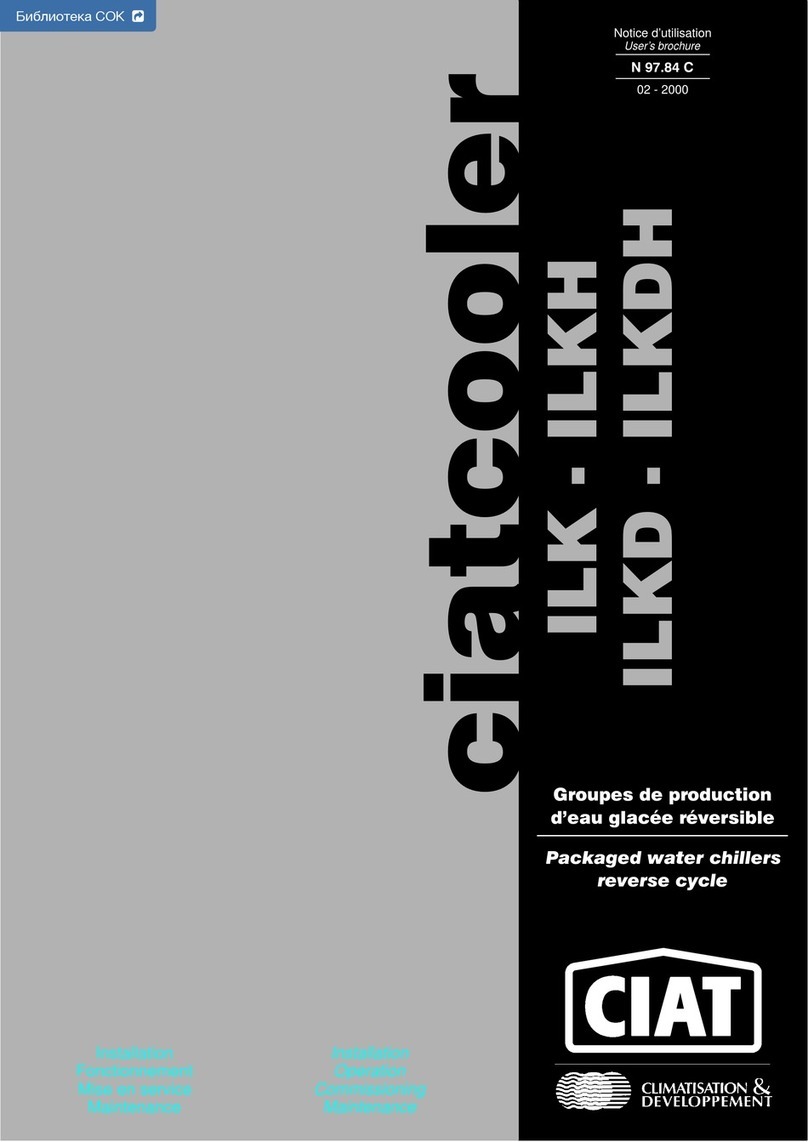
CIAT
CIAT ILK Installation, Operation, Commissioning, Maintenance

Carrier
Carrier PRO-DIALOG Plus 30GK Series Installation, operation & maintenance instructions
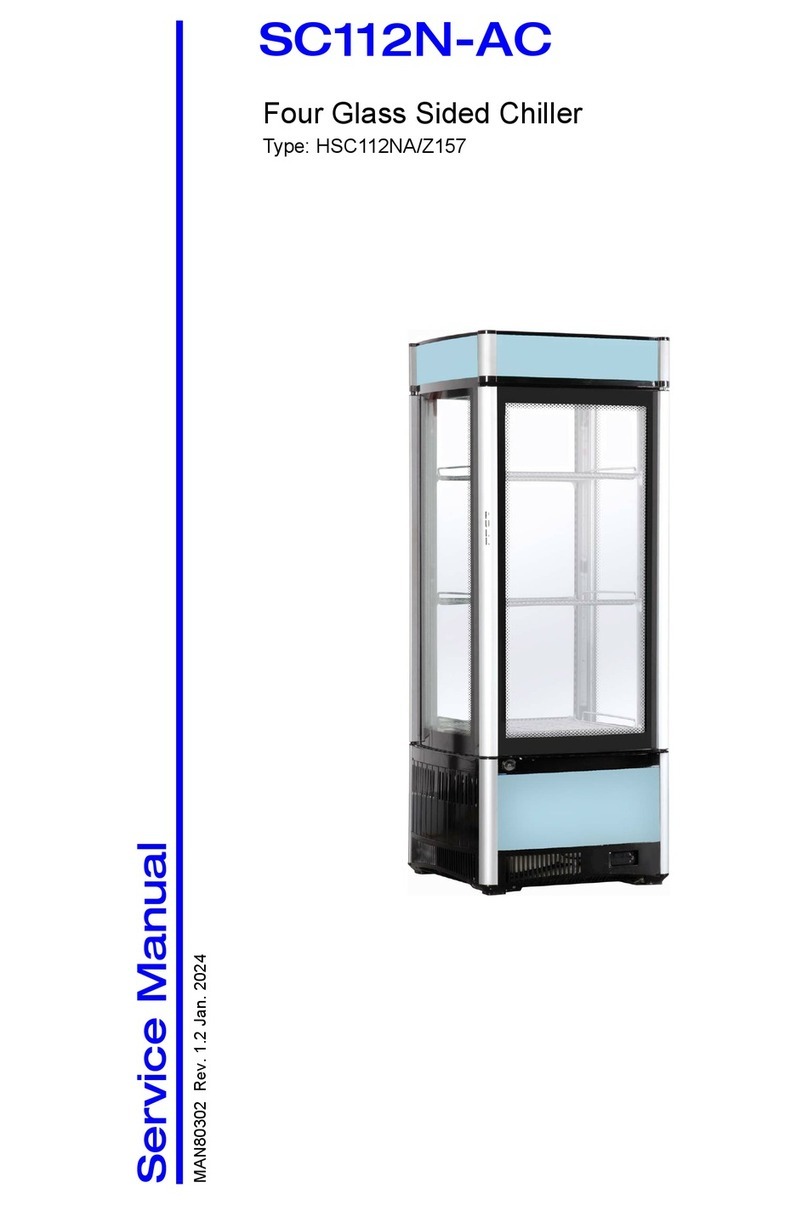
Skope
Skope SC112N-AC Service manual
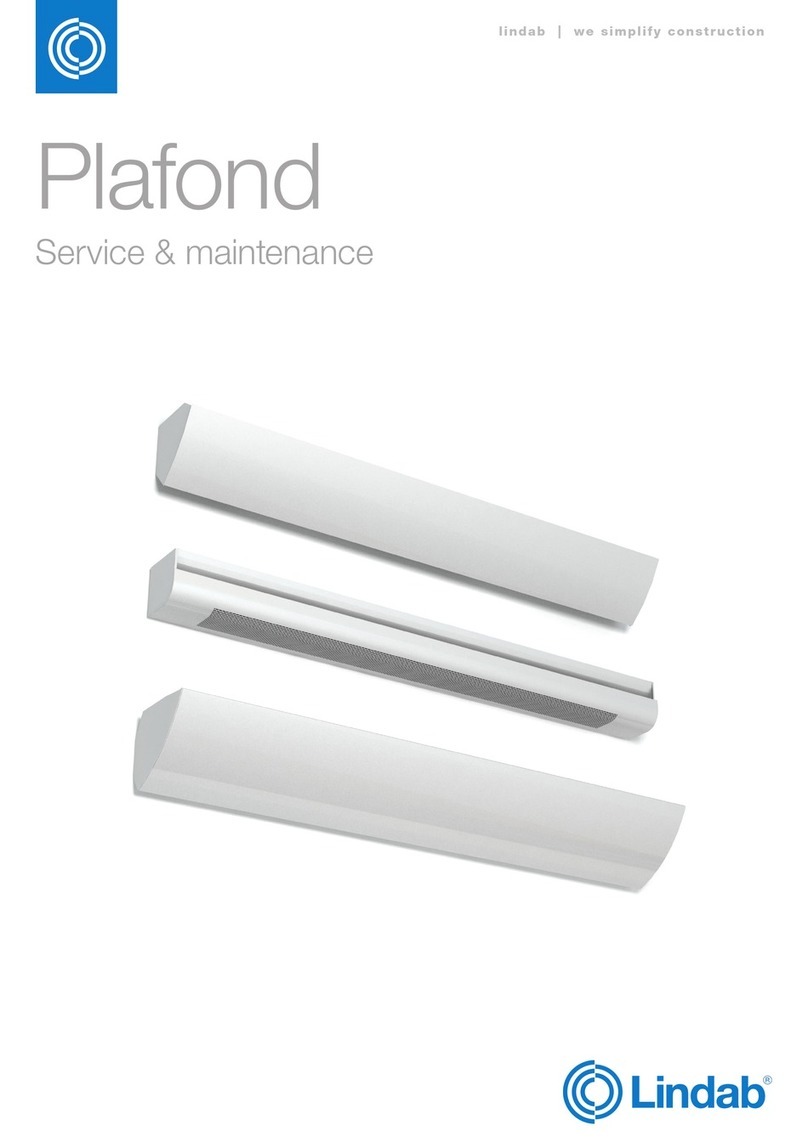
Lindab
Lindab Plafond Service maintenance manual
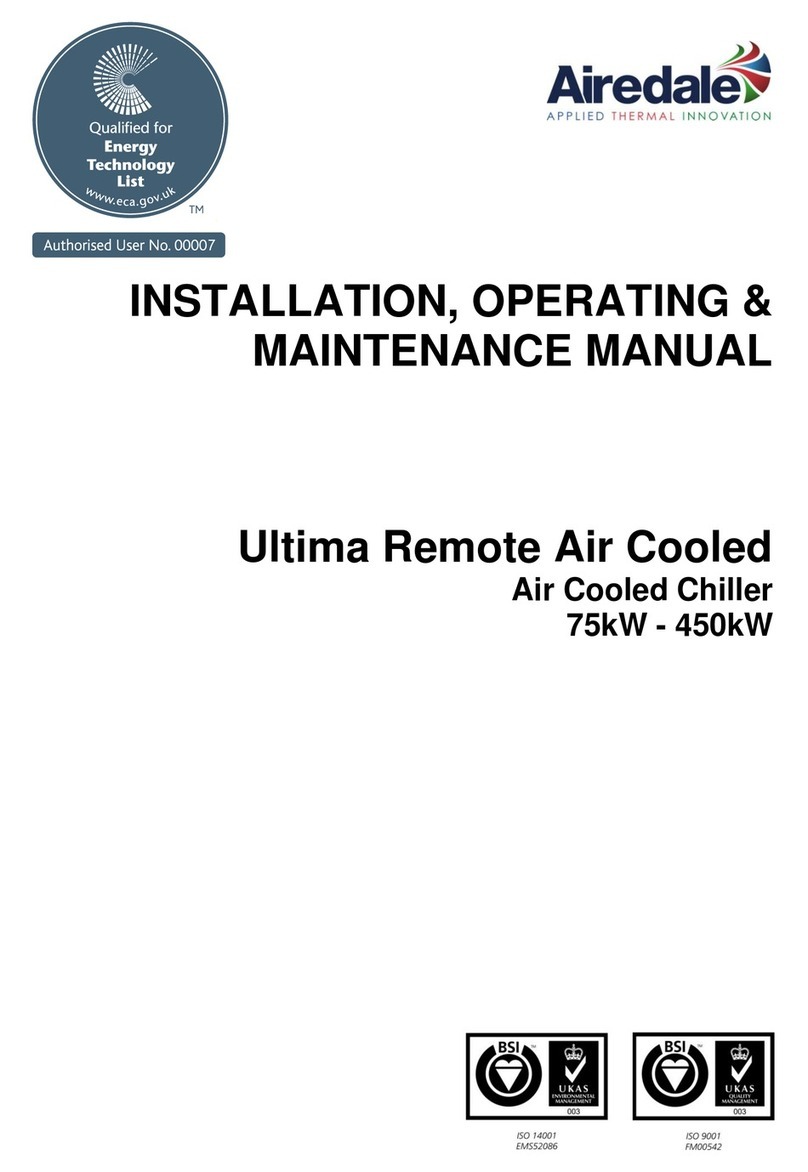
AIREDALE
AIREDALE Ultima Remote Air Cooled Installation, operating and maintenance manual
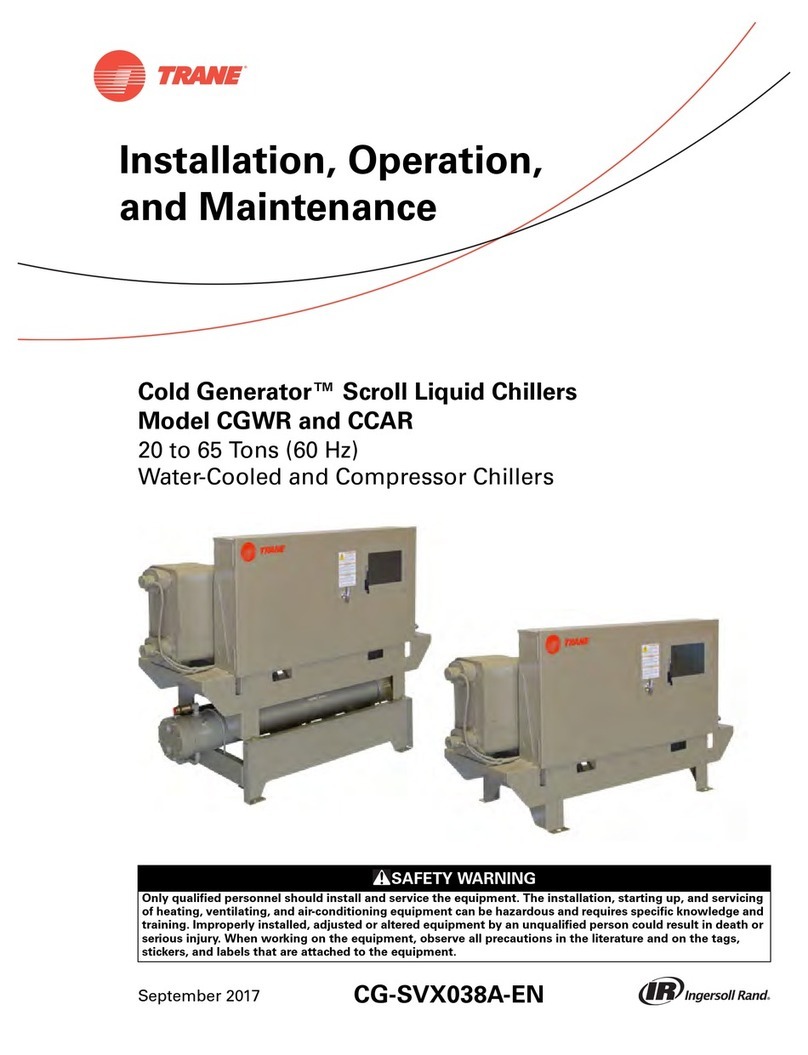
Trane
Trane Cold Generator CGWR Series Installation, operation and maintenance
